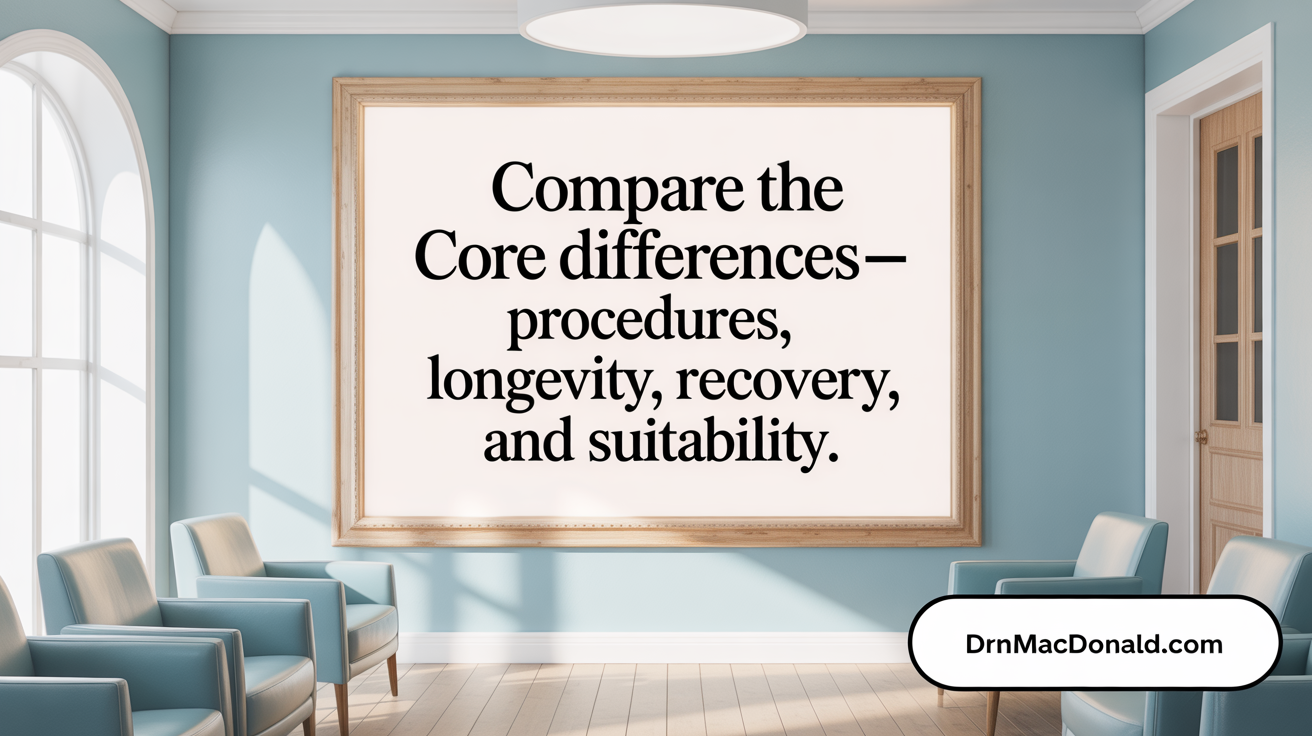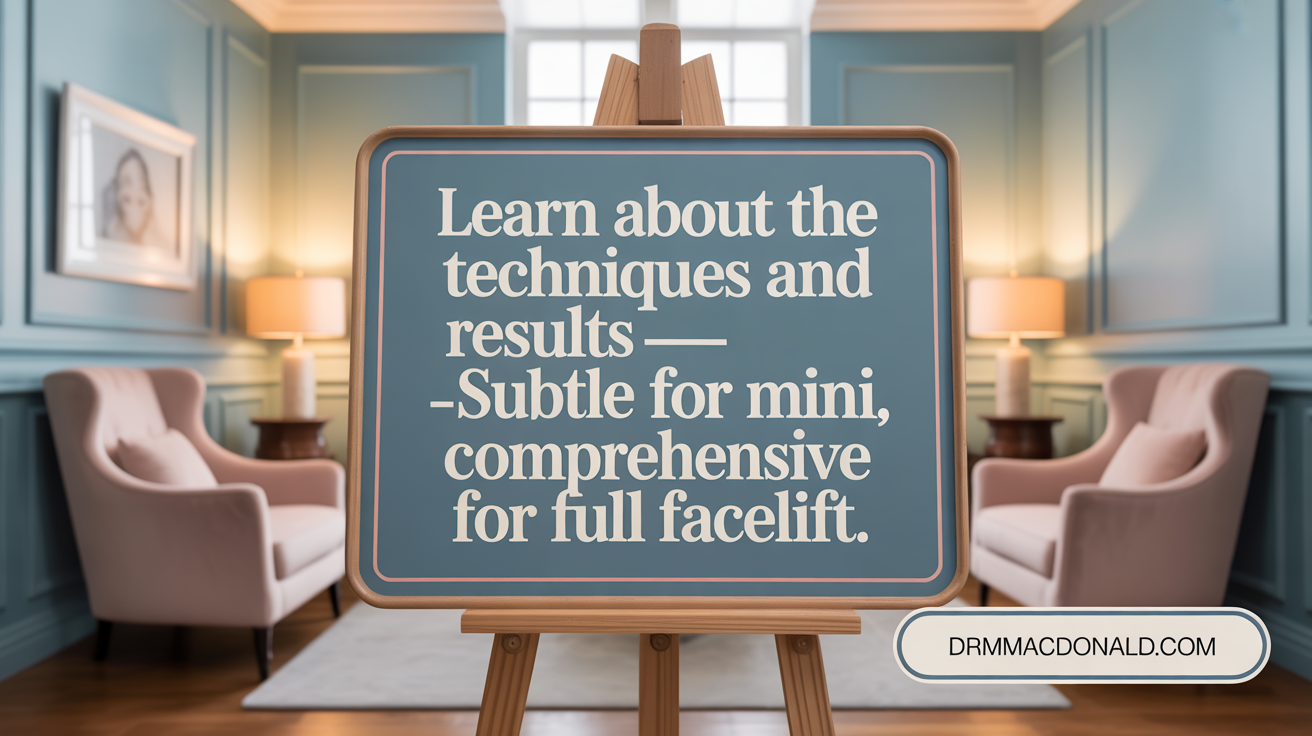Navigating Facelift Choices: Understanding Your Cosmetic Path
Choosing the right facelift procedure can be overwhelming given the variety of techniques, recovery times, and results available. Understanding the key differences and suitability of the mini facelift and full facelift is essential for making an informed decision that aligns with your facial aging concerns, lifestyle, and aesthetic goals. This article breaks down what each procedure entails, who they best serve, and the benefits and limitations, guiding you to the right choice with confidence.
Understanding the Core Differences Between Mini and Full Facelifts

What are the main differences between a mini facelift and a full facelift?
A mini facelift is a minimally invasive procedure designed to address minor sagging mainly in the lower face and jawline. It involves smaller incisions near the ears, less tissue dissection, and typically uses local anesthesia with sedation. Patients can expect a recovery time of about one week, making it a popular choice for younger individuals or those seeking subtle enhancements.
In contrast, a full facelift is a more comprehensive procedure that tackles moderate to severe signs of aging across the cheeks, jawline, midface, and neck. It involves longer incisions around and often behind the ears, with significant tissue lifting, tightening of underlying muscles, and sometimes removal of excess skin. This procedure is usually performed under general anesthesia and requires a recovery period of 2 to 3 weeks.
Results from a full facelift tend to last longer, usually around 7 to 10 years, whereas mini facelifts last approximately 2 to 6 years. The cost difference is notable as well, with full facelifts being more expensive due to their complexity. They are generally recommended for older patients with more advanced sagging, while mini facelifts suit younger patients experiencing early aging signs.
Overall, the main differences include the extent of surgical intervention, targeted areas, recovery times, and how long the results last. The choice depends on individual aging severity, personal goals, and medical advice from a qualified surgeon.
Who Should Consider a Mini Facelift or a Full Facelift?

Which candidates are best suited for a mini facelift versus a full facelift?
Deciding between a mini facelift and a full facelift depends on several individual factors, including age, degree of aging, skin condition, and personal goals.
Candidates ideal for a mini facelift are usually in their late 30s to 50s. They typically exhibit mild to moderate sagging in the lower face, such as the jawline and jowls, and have good skin elasticity. These patients seek subtle, natural improvements and prefer shorter recovery times, often around one week.
In contrast, full facelift candidates tend to be 50 or older, experiencing more advanced skin laxity, deep wrinkles, and significant sagging across the midface, jawline, and neck. They aim for more comprehensive and longer-lasting rejuvenation.
The full procedure involves more extensive surgery, longer recovery periods—generally about two weeks—and addresses deeper tissue layers, offering more dramatic and enduring results.
It's essential to evaluate the extent of aging signs and overall health in each patient.
Importance of an individualized assessment
Because every face ages differently, a personalized assessment by a qualified, board-certified plastic surgeon is crucial. The surgeon will examine skin quality, underlying tissue laxity, and the patient’s aesthetic goals.
This assessment helps determine which procedure aligns best with the patient’s needs, ensuring natural results while minimizing risks or unnecessary procedures.
Role of surgeon consultation
Consulting with an experienced surgeon allows patients to explore their options thoroughly. The surgeon can explain the technical aspects, expected outcomes, recovery process, and costs involved.
Through this detailed discussion, individuals can make informed decisions tailored to their unique facial features and aging signs, ensuring satisfaction with the final result.
Procedural Techniques and Expected Outcomes
 Mini facelifts focus on smaller, less invasive procedures designed to improve the lower face and jawline. They involve discreet incisions typically placed around the ears, which are shorter compared to full facelifts. During the surgery, only superficial tissues are tightened, which results in subtler, natural-looking improvements in contour and skin laxity. The effects generally last between five and ten years.
Mini facelifts focus on smaller, less invasive procedures designed to improve the lower face and jawline. They involve discreet incisions typically placed around the ears, which are shorter compared to full facelifts. During the surgery, only superficial tissues are tightened, which results in subtler, natural-looking improvements in contour and skin laxity. The effects generally last between five and ten years.
The process usually takes about 1 to 2 hours and is often performed under local anesthesia with sedation. Patients experience a quicker recovery, often returning to normal activities within a week, with minimal visible scarring.
In contrast, full facelifts are more comprehensive procedures that target the entire face, including midface, jowls, and neck regions. Surgeons use longer incisions, starting in the hairline, extending around the ears, and sometimes under the chin. This approach allows access to deeper tissue layers, such as the SMAS (Superficial Musculoaponeurotic System), which can be repositioned to achieve more dramatic results.
The duration of a full facelift typically ranges from 2.5 to 4 hours, performed under general anesthesia. It involves more extensive tissue manipulation, leading to significant lifting and tightening. The recovery period extends to about 2 to 3 weeks, with patients possibly experiencing swelling, bruising, and numbness.
Both procedures aim to reduce signs of aging—like wrinkles, sagging skin, and jowls—while restoring facial contours. Mini facelifts are suitable for early to moderate aging signs, offering a subtle rejuvenation that can last up to a decade. Full facelifts are ideal for individuals with more advanced aging, providing longer-lasting, more noticeable transformations typically lasting 10 to 15 years.
The choice of technique depends on factors such as age, skin elasticity, degree of sagging, and personal aesthetic goals. An experienced surgeon can help determine the most suitable option to achieve natural, balanced results with minimal visible scarring.
Recovery and Risks: What to Expect After Surgery

What is the typical recovery time and what risks are associated with mini facelifts and full facelifts?
Recovery periods differ significantly between the two procedures. For a mini facelift, patients usually feel ready to return to non-strenuous activities within about 5 to 7 days. Swelling and bruising tend to last a few days up to two weeks, and complete healing typically occurs within 2 to 3 weeks. This shorter recovery makes mini facelifts a popular choice for those seeking subtle rejuvenation with minimal downtime.
In contrast, a full facelift involves a longer recovery process. Patients generally require about two to three weeks off work, with swelling and bruising peaking in the initial days and gradually improving over several weeks. The full procedure addresses more extensive signs of aging, and the recovery may take longer because it involves more tissue manipulation and longer incisions.
Both procedures carry some common risks, including swelling, bruising, numbness, infection, hematoma (a collection of blood under the skin), and scarring. Serious complications are rare when the procedures are performed by qualified surgeons. Good post-operative care and proper precautions can significantly reduce these risks.
Regarding lasting effects, mini facelift results typically last 5 to 10 years, while full facelift outcomes may endure 10 to 15 years. The full facelift tackles more extensive aging signs, offering more dramatic and longer-lasting rejuvenation.
Choosing between these options depends on individual aging severity, recovery preferences, and aesthetic goals. Surgeons assess these factors during consultation to recommend the most suitable approach, emphasizing that proper aftercare and surgeon expertise are crucial for safe recovery and optimal results.
Cost Considerations and Long-Term Value
How do the costs of mini facelifts compare to full facelifts?
Mini facelifts are generally more affordable than full facelifts. Typically, mini procedures cost between $6,000 and $12,000, whereas full facelifts range from about $20,000 to $27,000. The main reasons for this difference are the shorter surgical time, less extensive tissue manipulation, and smaller areas being addressed in mini procedures. This results in reduced operating room time, anesthesia costs, and recovery expenses.
What factors influence price variations?
Several factors can cause the price of these procedures to vary. Key considerations include geographic location—cosmetic surgeries tend to be pricier in large urban centers like New York City or Los Angeles—and surgeon experience and reputation. Highly experienced, board-certified surgeons tend to charge more due to their skill and proven results. The complexity of the individual case, additional treatments integrated into the procedure, and facility fees also impact pricing.
How do recovery periods affect overall costs?
Recovery duration influences overall costs, especially if patients need paid time off work or additional post-operative care. Mini facelifts usually require about 7–10 days for recovery, enabling patients to return to normal routines quickly, often minimizing lost wages and additional expenses. Full facelifts, requiring 10–14 days of recovery, may involve more extended time off work and higher costs related to post-surgical support or care.
What is the value based on longevity of results?
While mini facelifts offer a quicker, less invasive solution with results lasting about 5–10 years, full facelifts provide longer-lasting rejuvenation, typically 10–15 years, and more dramatic improvements. Durability and the extent of correction should be factored into the overall value—longer-lasting results from a full facelift could justify the higher initial investment for many patients.
Why is the surgeon's experience important?
Choosing a skilled, board-certified plastic surgeon is crucial for achieving optimal results and minimizing risks such as scarring, nerve damage, or infection. Experienced surgeons tend to charge higher fees but provide safer procedures, better aesthetic outcomes, and longer-lasting results. Consulting with a qualified professional ensures the procedure aligns with your goals and health status.
How should patients financially plan for cosmetic surgery?
Patients should consider all associated costs, including the surgery, anesthesia, facility fees, recovery expenses, and potential follow-up treatments. Creating a financial plan or saving ahead of time can help avoid financial stress. Some clinics offer payment plans or financing options, making procedures more accessible.
| Aspect | Mini Facelift | Full Facelift | Details |
|---|---|---|---|
| Cost Range | $6,000–$12,000 | $20,000–$27,000 | Varies by location, surgeon, and complexity |
| Recovery Time | 7–10 days | 10–14 days | Affects associated costs like time off work |
| Result Duration | 5–10 years | 10–15 years | Longer results tend to justify higher costs |
| Surgical Approach | Less invasive | More invasive | Deep tissue repositioning in full facelift |
| Ideal Candidates | Younger, mild sagging | Older, significant sagging | Based on extent of aging |
Ultimately, balancing costs with desired longevity, safety, and aesthetic goals is essential. Patients are encouraged to consult experienced surgeons to evaluate their options carefully and select the procedure that offers the best long-term value for their personal needs.
Choosing the Most Natural and Effective Facelift Approach

What is the most natural-looking facelift technique available?
The deep plane facelift is widely regarded as the best technique for achieving natural-looking results. Unlike traditional methods that mainly tighten the skin, the deep plane technique involves repositioning the deeper layers of facial tissue, including muscles and fat pads. This approach addresses the root causes of sagging and volume loss, helping restore a youthful, natural contour.
By lifting and repositioning these structural components, the deep plane facelift creates a revitalized appearance that respects the face's original anatomy and natural aging process. It minimizes surface tension and avoids a tight or artificially stretched look, which can be common with more invasive or superficial procedures. Patients often notice how their results look harmonious with their natural facial features.
The longevity of these results also contributes to its popularity. Since it targets deeper tissues, the effects tend to last longer—often between 10 to 15 years—making it a durable choice for those seeking authentic rejuvenation.
Overall, the deep plane facelift is considered the gold standard for natural results, offering a subtle, youthful elevation that authentically reflects the patient's original facial anatomy and aging pattern.
How are natural results achieved?
Achieving natural results depends heavily on the surgeon’s skill and understanding of facial anatomy. Precise technique in redistributing facial tissues, careful management of skin and fat, and attention to maintaining facial expressions all contribute to a harmonious look.
Surgeons aim to lift the face in a vertical direction, mirroring the natural aging process, rather than pulling tissues laterally. This approach ensures the face maintains its natural expression and softness.
Why is surgeon certification important?
Choosing a qualified, board-certified plastic surgeon is crucial for safety and optimal results. These surgeons have undergone rigorous training, assessment, and continuous education in facial surgeries. Certification assures that they adhere to the highest standards of safety, artistry, and ethical practice.
Patients should inquire about their surgeon’s experience specifically with deep plane facelifts, review before-and-after photos, and discuss their particular goals and concerns.
Combining facelifts with adjunct treatments
Voicing realistic expectations, many patients enhance their facelift results through additional treatments like Botox for dynamic wrinkles, fillers to restore volume, or skin resurfacing for texture and tone. Combining procedures can produce more comprehensive rejuvenation tailored to individual needs.
Personalizing the procedure based on anatomy and goals
Every face is unique. Surgeons evaluate facial features, skin quality, bone structure, and aging signs to customize the approach. For some, a deep plane facelift alone may suffice, while others may benefit from combined treatments or less invasive options.
Open communication and a detailed consultation help ensure the chosen procedure aligns with personal goals and anatomy, leading to the most natural and satisfying results.
Making an Informed Facelift Choice
Ultimately, deciding between a mini facelift and a full facelift hinges on your unique facial aging needs, lifestyle, and aesthetic aspirations. While mini facelifts offer a quicker, less invasive option ideal for mild to moderate aging in younger patients, full facelifts provide a comprehensive, longer-lasting solution that addresses deeper structural changes and more advanced aging signs. Consulting a board-certified, experienced plastic surgeon is crucial to evaluate your skin elasticity, facial anatomy, and goals to recommend the procedure best suited for you. Embracing this informed approach not only ensures optimal, natural-looking results but also a smoother recovery and greater satisfaction with your facial rejuvenation journey.
References
- Full or Mini Facelift: Which is Right for Me? | University of Utah Health
- Mini vs. Full Facelift: Choosing the Right Procedure for You
- Full Facelift vs. Mini Face Lift: What's the Difference?
- Full Facelift vs Mini Facelift - Anthony MacQuillan Plastic Surgeon
- Mini Facelift vs Traditional Facelift: Which Is Right for You?
- What is the difference between a Mini Facelift and a full Facelift?
- Mini Face Lift vs. Full Face Lift: Which One Is Right For You?
- Mini vs Full Facelift Surgery: What Is the Difference? | Dr. Mussat
- Choosing Between a Full Facelift and a Mini-Facelift: Which Is Right ...
- Mini Facelift vs Lower Facelift - What's the difference?
